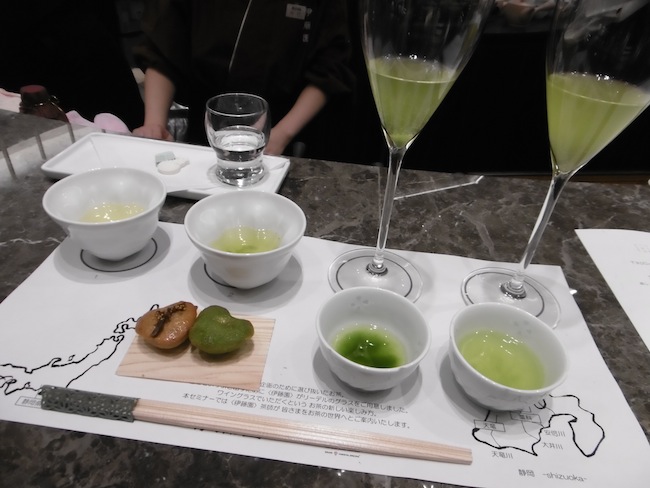
Green tea has always been a popular drink in Japan and is widely consumed here even in plastic bottles. Visitors to Japan are sure to have seen a variety of green tea drinks at convenience stores or vending machines, including those from major tea and beverage maker Ito En.
Now, Ito En and department store Isetan have teamed up to put on a delightful promotional event which they’re calling the “Green Tea Party“, and the event is exactly that – one big tea party, where you can have so many different types of green tea and tea-based beverage creations that you’ll feel like you stepped into a wonderland of Japanese tea. Naturally, we weren’t about to stay away from a good tea party, so we made our way to the branch of Isetan in Tokyo’s Shinjuku neighborhood. Let’s take a look at what we saw and tasted at the event, shall we?
When we reached the store’s fifth floor, where most of the green tea action was going on, we first caught sight of a promotion for a very special gyokuro version of the popular Oi Ocha tea drink from Ito En, which readers may recall we introduced in a previous article.
What’s so special about these beautifully wrapped drinks? Well, they’re made completely from valuable gyokuro green tea leaves, which are carefully grown in the shade for a period of approximately three weeks before picking. The leaves are highly prized for the concentrated flavor they carry as a result of being shielded from the sun in their final stage of growth.
▼ The gyokuro Oi Ocha is beautifully packaged and sells for a cool 1,188 yen (US$9.64) for a 375-milliliter (12.7-ounce) bottle!
And the great part was that they were serving complimentary samples of the special Oi Ocha, and in a wine glass from high-end Austrian wine glass maker Riedel. Even better, the particular wine glass was specifically selected from Ridel’s numerous products after careful tasting to determine which glass was the best match for the gyokuro drink!
They ended up selecting a new world Pinot Noir glass for the gyokuro Oi Ocha, and it tasted excellent, much richer than the usual bottled green tea. And we have to admit, the glass makes it look very elegant as well.
▼ The were also serving green tea infused with various dried fruit, which added a nice zest to the resulting drink.
Next, we made our way to the “Kitchen Dining/Taste of Drink” counter also located on the fifth floor, where they were conducting a unique green tea tasting seminar. You get to taste different teas prepared in different ways by a tea specialist from Ito En and served in different glasses, again including specifically selected Riedel glassware.
▼ The menu included a tasting seminar of a selection of several teas, as well as servings of individual teas grown and processed using different methods. Most were teas grown in Shizuoka, a prefecture located on the southern coast of central Japan and famous for producing excellent green tea.
▼ The setting at the counter included a paper place mat with a map of Japan and of Shizuoka drawn on it.
▼ Here’s the map of Shizuoka Prefecture, with some of the major tea producing areas indicated.
We of course wanted to try the tasting seminar offering the chance to taste a variety of teas served as a set, but before that, we tried some deep steamed (fukamushi) sencha green tea (540 yen [$4.38]) from the Kawane area of Shizuoka.
▼ This is what the tea looked like.
▼ The tea was brewed right in front of us. Japanese green tea is typically prepared at a lower temperature than English tea, usually 70-80 degrees Celsius (158-176 degrees Farenheit) or even as low as 50 degrees Celsius C (122 degrees Farenheit) for gyokuro.
▼ And we have tea in a beautiful green color!
▼ This particular tea was served in a Riedel Shiraz glass, and it was flavorful yet refreshing!
▼ We even received a serving of delicate sugar confections in adorable snowflake and snowman designs.
And now, on to the tasting seminar! We first tried some light roasted (asamushi) sencha from the Tenryu area of Shizuoka Prefecture.
▼ The light steamed tea wasn’t very dark in color, almost golden, but it had a lovely aroma.
▼ Next came the same sencha tea from Tenryu, but deep steamed. The color was darker, and the slightly bitter yet refreshing flavor of green tea was evident.
▼Next came an interesting combination — the same deep steamed tea in a Riedel champagne flute!
▼ Beautifully elegant, and a wonderful way to enjoy the aroma of the tea!
▼ We were also treated to a cold version of the same deep steamed tea from Tenryu, brewed from cold water.
▼ The cold tea, pictured here on the right, was also served in a champagne flute and tasted mellow, even slightly sweet.
Next, we had a kabusecha, a type of tea grown covered under a net for about a week before picking. This kabusecha was produced in the Warashina area of Shizuoka and was stored in a traditional Japanese-style warehouse to mature before brewing. Both the color and flavor were rich and strong.
The last tea we tried was also a kabusecha, grown in the Yame district of Fukuoka Prefecture in the southern island of Kyushu. In addition to having been covered under a net for the last week of their growth, this tea has also been lightly roasted over a charcoal fire, giving it a slightly smoky aroma.
In the end, we tasted six tea drinks and were even served two small financier cakes for a price of 1,404 yen ($11.40), which we have to say really wasn’t a bad deal, especially considering the quality of the tea that was being used!
But the green tea fun didn’t stop there. After the seminar, we made our way to the “Ito En Tea Bar“right next to the tasting counter.
▼ The beverage menu consisted of four creations by tea sommelier Yu Kato, all of them sounding tantalizingly delicious.
▼ We decided to have the “Matcha x Tiramisu” drink (1,404 yen [$11.40]) first. The drink was served in a Riedel champagne flute, with a chestnut paste placed at the bottom, and cold matcha green tea beat to a frothy consistency poured over it.
▼ The green of the matcha with the lighter colored foam resting at the top created a beautiful color pattern.
▼ Small flakes of gold leaf were sprinkled on top.
But that’s not all. This drink came with a special monaka confection. Monaka typically consist of crispy wafer shells filled with bean paste, but the monaka in this case contained a combination of mascarpone cheese and chestnut cream!
▼ Here’s the sphere-shaped monaka…
▼ …presented elegantly on top of the glass.
▼ The bitter flavor of the matcha green tea and the chestnut paste made for a pleasant combination.
The cream-filled monaka was absolutely divine. What’s amazing is that the drink has been carefully designed so that when you have it together with the monaka, it combines to create a taste in your mouth like tiramisu cake!
Next, we had the Hojicha (roasted green tea) Chai Latte with Three Spices (864 yen [$7.01]). Red pepper, cardamon and clove were used to give the latte a spicy zest.
▼ The three spices were ground…
▼ …and brewed in a pot.
▼ Quality wasanbon sugar was then added to another pot…
▼ …which was combined with the brewed spices and roasted tea.
▼ This is the result, served in a Riedel Riesling glass.
▼ Foamed milk was poured on top…
▼ …with a sprinkling of hojicha powder to complete the drink.
▼ With the milk and spices, the drink was mild and relaxing, perfect for winding down before going to bed.
Also on the menu was the Green Tea x Dried Fruits drink (756 yen [$6.14]). First, pieces of dried orange and lemon were placed in a pot, which was then filled with hot water.
Once the water was infused with the flavor and fragrance of the fruit, it was poured into another pot containing green tea.
▼ Some of the fruit was placed in a new world Pinot Noir glass.
▼ The hot water in the pot of green tea was extracted into the first pot containing the fruit.
▼ And we had the finished drink!
▼ The light orange color form the fruit was beautiful!
▼ We also got a serving of lavender honey which we could added halfway through our drink.
This drink was a pleasant surprise, as the aroma smelled strongly of citrus, and when tasted, there was a definite fruit flavor. However, the refreshing light taste of green tea was clearly there as well.
Lastly, we had the Genmaicha (brown rice tea) with a Pink Plum Espuma drink (1,080 yen [$8.77]). Now, just the name of the drink alone sounds fascinating!
First they brewed a pot of brown rice tea. It was surprising to see how bright green the tea was.
Next, a blend of plum paste and gelatin was whipped into an espuma.
▼ The brown rice tea was cooled in a pot of ice…
▼ …then poured into a Riedel coupe glass.
▼ The espuma was poured over the tea.
▼ Cute little rice crackers were sprinkled on top of the pale pink foam, creating a stunning visual effect.
▼ And there you have the finished drink!
This drink was served with a stylish monaka filled with traditional red bean paste and pieces of dried yuzu citrus on top. Yum!
▼ The flavor of the plum in the espuma added a delightful bit of tang to the light fresh taste of the brown rice tea.
So, that brings us to the end of our report on the Green Tea Party at Shinjuku Isetan. We certainly had a wonderful time trying all these different teas, and we’re sure anyone who has even a remote interest in tea would find it a fascinating experience.
The event itself will be going on until November 10, and while the gyokuro Oi Ocha service is held only on select days, the tasting seminar is held four to five times daily, and the Ito En Tea Bar is open throughout the day. If you do have the chance to be in the area, it’s definitley worth visiting the department store for the various teas and the creative drinks — it really is a veritable green tea feast!
Photos ©RocketNews24










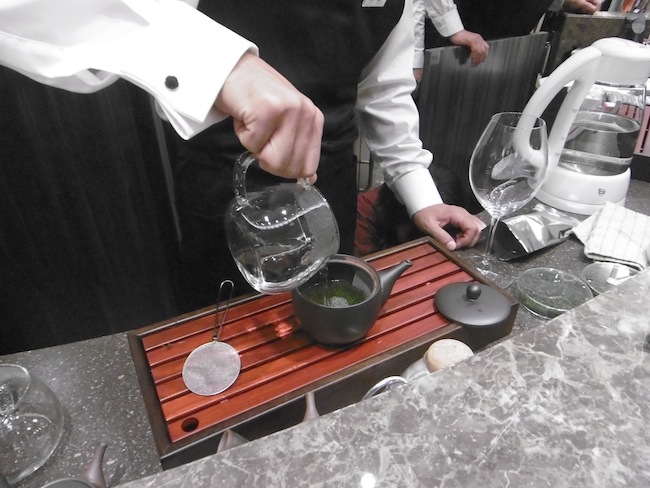










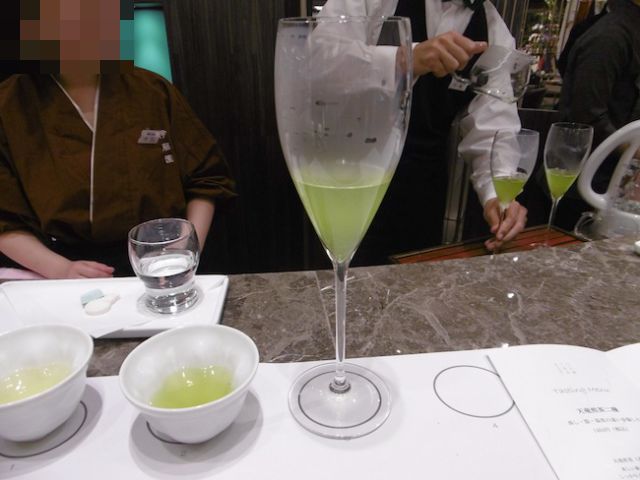



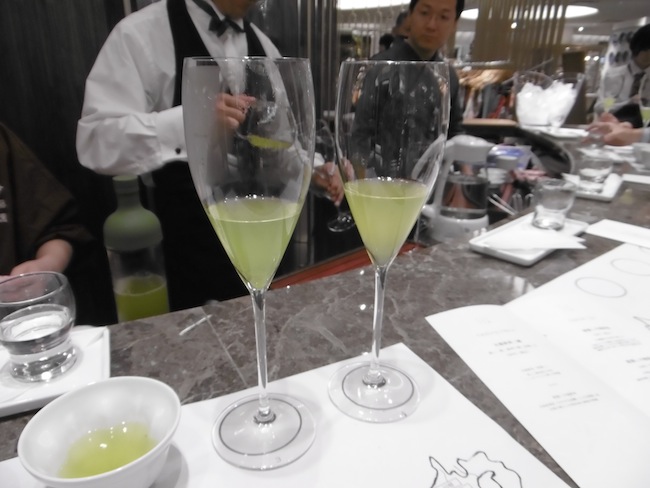































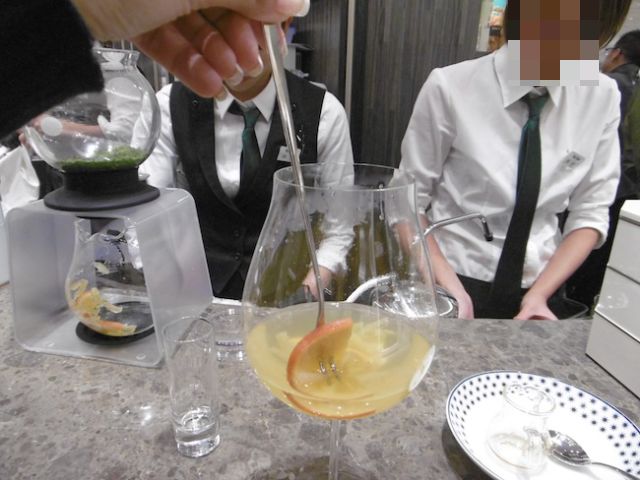













 Japan’s Oi Ocha green tea keeps going upscale with new bottled matcha costing 1,000 yen a bottle
Japan’s Oi Ocha green tea keeps going upscale with new bottled matcha costing 1,000 yen a bottle Is this $900 box of Japanese chocolates the perfect indulgence for sweets lovers?
Is this $900 box of Japanese chocolates the perfect indulgence for sweets lovers? Stylish green tea “chablets” from Shizuoka are our new way favorite way to grab a cuppa
Stylish green tea “chablets” from Shizuoka are our new way favorite way to grab a cuppa Häagen-Dazs Japan’s Yuzu Green Tea Float — How to make the super-easy matcha summer dessert drink
Häagen-Dazs Japan’s Yuzu Green Tea Float — How to make the super-easy matcha summer dessert drink McDonald’s Japan releases matcha green tea cake, frappes and lattes for a limited time
McDonald’s Japan releases matcha green tea cake, frappes and lattes for a limited time Japan’s new difficult-to-drink-from beer glass protects your liver, but it’s a brutal experience
Japan’s new difficult-to-drink-from beer glass protects your liver, but it’s a brutal experience New Pokémon ice cream, dessert drinks, and cool merch coming to Baskin-Robbins Japan【Pics】
New Pokémon ice cream, dessert drinks, and cool merch coming to Baskin-Robbins Japan【Pics】 New samurai glasses are Japan’s latest weird must-have souvenir
New samurai glasses are Japan’s latest weird must-have souvenir Demon Slayer: Kimetsu no Yaiba gets new roller coaster attractions and food at Universal Studios Japan
Demon Slayer: Kimetsu no Yaiba gets new roller coaster attractions and food at Universal Studios Japan How to order snacks on a Shinkansen bullet train in Japan
How to order snacks on a Shinkansen bullet train in Japan High-fashion Totoro cuddle purse is like an elegant stroll in the forest【Photos】
High-fashion Totoro cuddle purse is like an elegant stroll in the forest【Photos】 Kyoto Tower mascot termination reveals dark side behind cute Japanese characters
Kyoto Tower mascot termination reveals dark side behind cute Japanese characters Caffeinated ramen for gamers that you can eat with one hand going on sale in Japan
Caffeinated ramen for gamers that you can eat with one hand going on sale in Japan Burger King Japan suddenly adds Dr. Pepper and Dr. Pepper floats to its menu nationwide
Burger King Japan suddenly adds Dr. Pepper and Dr. Pepper floats to its menu nationwide Hello, cosmetics! Clinique teams up with Hello Kitty this summer for first-time collaboration
Hello, cosmetics! Clinique teams up with Hello Kitty this summer for first-time collaboration Nintendo history you can feel – Super NES, N64, and GameCube controllers become capsule toys
Nintendo history you can feel – Super NES, N64, and GameCube controllers become capsule toys “The most Delicious Cup Noodle in history” – Japan’s French Cup Noodle wins our heart【Taste test】
“The most Delicious Cup Noodle in history” – Japan’s French Cup Noodle wins our heart【Taste test】 Starbucks releases a cute Frappuccino and Unicorn Cake…but not in Japan
Starbucks releases a cute Frappuccino and Unicorn Cake…but not in Japan McDonald’s Japan’s Soft Twist Tower: A phantom ice cream only sold at select branches
McDonald’s Japan’s Soft Twist Tower: A phantom ice cream only sold at select branches Yabai Ramen: What makes this Japanese ramen so dangerous?
Yabai Ramen: What makes this Japanese ramen so dangerous? Finally! Nintendo Japan expands Switch 8-bit controller sales to everybody, Online member or not
Finally! Nintendo Japan expands Switch 8-bit controller sales to everybody, Online member or not Japanese government wants to build luxury resorts in all national parks for foreign tourists
Japanese government wants to build luxury resorts in all national parks for foreign tourists To combat declining birth rate, Japan to begin offering “Breeding Visas” to foreigners
To combat declining birth rate, Japan to begin offering “Breeding Visas” to foreigners 10 things you should buy at 7-Eleven in Japan
10 things you should buy at 7-Eleven in Japan Studio Ghibli releases anime heroine cosplay dresses that are super comfy to wear
Studio Ghibli releases anime heroine cosplay dresses that are super comfy to wear Woman charged for driving suitcase without a license in Osaka
Woman charged for driving suitcase without a license in Osaka Studio Ghibli unveils My Neighbour Totoro miniature house model
Studio Ghibli unveils My Neighbour Totoro miniature house model Kyoto experiencing problems with foreign tourists not paying for bus fares, but not on purpose
Kyoto experiencing problems with foreign tourists not paying for bus fares, but not on purpose Fighting mild hunger with a Japanese soda that turns into jelly in the stomach【Taste test】
Fighting mild hunger with a Japanese soda that turns into jelly in the stomach【Taste test】 Studio Ghibli’s Howl’s Moving Castle tapestry unveiled in Japan for first time
Studio Ghibli’s Howl’s Moving Castle tapestry unveiled in Japan for first time McDonald’s new Happy Meals offer up cute and practical Sanrio lifestyle goods
McDonald’s new Happy Meals offer up cute and practical Sanrio lifestyle goods Sales of Japan’s most convenient train ticket/shopping payment cards suspended indefinitely
Sales of Japan’s most convenient train ticket/shopping payment cards suspended indefinitely Sold-out Studio Ghibli desktop humidifiers are back so Totoro can help you through the dry season
Sold-out Studio Ghibli desktop humidifiers are back so Totoro can help you through the dry season Japanese government to make first change to romanization spelling rules since the 1950s
Japanese government to make first change to romanization spelling rules since the 1950s Foreigner’s request for help in Tokyo makes us sad for the state of society
Foreigner’s request for help in Tokyo makes us sad for the state of society Ghibli founders Toshio Suzuki and Hayao Miyazaki contribute to Japanese whisky Totoro label design
Ghibli founders Toshio Suzuki and Hayao Miyazaki contribute to Japanese whisky Totoro label design Doraemon found buried at sea as scene from 1993 anime becomes real life【Photos】
Doraemon found buried at sea as scene from 1993 anime becomes real life【Photos】 Tokyo’s most famous Starbucks is closed
Tokyo’s most famous Starbucks is closed Princesses, fruits, and blacksmiths: Study reveals the 30 most unusual family names in Japan
Princesses, fruits, and blacksmiths: Study reveals the 30 most unusual family names in Japan Japan’s new 2,500-yen Ultimate Matcha Latte Float takes green tea to a whole new level
Japan’s new 2,500-yen Ultimate Matcha Latte Float takes green tea to a whole new level Does Japan’s green tea white wine taste like tea, wine, or something else entirely?【Taste Test】
Does Japan’s green tea white wine taste like tea, wine, or something else entirely?【Taste Test】 Nestlé Japan releases new green tea Kit Kats as part of their “I LOVE TEA” series
Nestlé Japan releases new green tea Kit Kats as part of their “I LOVE TEA” series Japan’s massive matcha parfait weighs 6 kilos, contains hidden surprises for anyone who eats it
Japan’s massive matcha parfait weighs 6 kilos, contains hidden surprises for anyone who eats it Sharp’s Ocha-presso brings traditional Japanese flavor to your kitchen
Sharp’s Ocha-presso brings traditional Japanese flavor to your kitchen Enjoy beautiful Japanese snacks and tea at Saryo Fukucha in Kyoto
Enjoy beautiful Japanese snacks and tea at Saryo Fukucha in Kyoto Krispy Kreme’s new line of doughnuts offers plenty of Japanese tea goodness
Krispy Kreme’s new line of doughnuts offers plenty of Japanese tea goodness Merry matcha! Starbucks Japan adds two subtly changed, deliciously different green tea beverages
Merry matcha! Starbucks Japan adds two subtly changed, deliciously different green tea beverages Starbucks’ new matcha cheese Frappuccino is here, but can this crazy combo work?【Taste test】
Starbucks’ new matcha cheese Frappuccino is here, but can this crazy combo work?【Taste test】 Japanese tea commercial actress created by AI, has some wondering if it’s the scandal-free future
Japanese tea commercial actress created by AI, has some wondering if it’s the scandal-free future 7 Halloween-themed afternoon teas you won’t want to miss this year
7 Halloween-themed afternoon teas you won’t want to miss this year Kyoto matcha green tea popcorn, the latest must-eat snack from…Frito-Lay?!?
Kyoto matcha green tea popcorn, the latest must-eat snack from…Frito-Lay?!? Mister Donut demonstrates the wonders of hot bubble tea with royal milk and rich matcha flavors
Mister Donut demonstrates the wonders of hot bubble tea with royal milk and rich matcha flavors We try the four new offerings in the Mister Donut x Gion Tsujiri collaboration series【Taste test】
We try the four new offerings in the Mister Donut x Gion Tsujiri collaboration series【Taste test】 Matcha green tea meets strawberries in Japan-exclusive drinks from The Coffee Bean & Tea Leaf
Matcha green tea meets strawberries in Japan-exclusive drinks from The Coffee Bean & Tea Leaf Feeling cold? Relax over a hot cup of fragrant sakura tea from Lipton!
Feeling cold? Relax over a hot cup of fragrant sakura tea from Lipton!
Leave a Reply